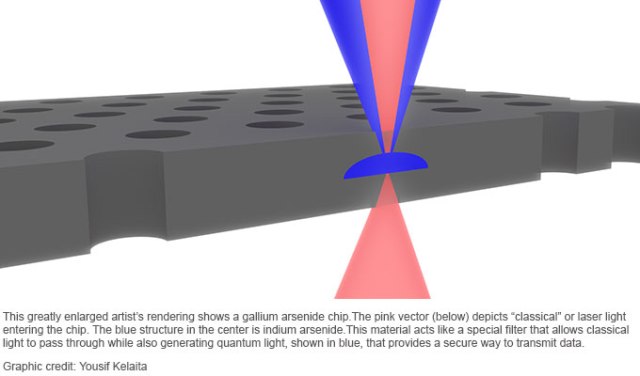Jan 29 2016
Imagine communicating with your bank, the IRS or your doctor by way of an Internet that was perfectly secure. Your most private data would be protected with absolute certainty and, better yet, if any bad actor were to try to eavesdrop you would know immediately. Such is the promise of secure quantum communication.

Should quantum communication ever become the standard—if there is ever to be a quantum Internet, for instance—technical challenges lie ahead. Among the most critical will be devices that can send and receive quantum data. To that end, researchers at Stanford University have created a novel quantum light source that might someday serve as the basis for quantum communication. They explained their findings in a paper published by the journal Nature Photonics.
The physics of quantum communication is admittedly complex. Standard lasers are actually not useful for secure communication because they emit what is called “classical” light. Data eavesdroppers could extract any data being carried via classical light without detection. In contrast, a quantum Internet would be based on “quantum” light, in which a single unit of light—a single photon—cannot be measured without being destroyed. Therefore, an efficient source of quantum light would enable perfectly secure communication.
Senior author Jelena Vuckovic, a professor of electrical engineering at Stanford, has been working for years to develop various nanoscale lasers and quantum technologies that might help conventional computers communicate faster and more efficiently using light instead of electricity. She and her team, including lead author Kevin Fischer, a doctoral candidate, realized that a modified nanoscale laser can be used to efficiently generate quantum light for quantum communication.
“The problem is that the quantum light is much weaker than the rest of the light coming from such a modified laser—it is difficult to pick up,” Vuckovic said. “So, we created a way to filter out the unwanted light, allowing us to read the quantum signal much better.”
The filtering works in a fashion similar to the way noise-canceling headphones operate, only with light, instead of sound. With the headphones, a sensor actively gauges the frequency of relatively constant ambient sound—the rumble of traffic, the drone of an airplane engine, the thrum of a refrigerator—and produces a similar pattern, which can be used to cancel out the undesirable sound.
“Some of the light coming back from the modified laser is like noise, preventing us from seeing the quantum light,” Fischer said. “We canceled it out to reveal and emphasize the quantum signal hidden beneath.”
Vuckovic’s team adapted an interference technique borrowed from 1930s-era radio engineering to cancel the unwanted classical light. They first figured out what the “noise” looks like and played it back. By carefully adjusting how the canceling light and the classical light overlap, the unwanted light is canceled and the once-hidden quantum light is revealed.
“This is a very promising development,” Vuckovic said. “It provides us with a practical pathway to secure quantum communications.”
She and her team are now working on creating a working prototype, but that will have to wait for another paper.